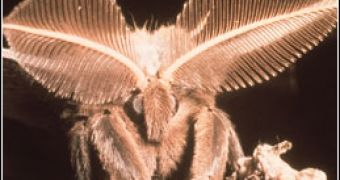Many aliens in the SF movies are inspired from insects; or perhaps vertebrates represent strange aliens for them. A new study to be published in "Nature" by a team of researchers from Rockefeller University and the University of Tokyo adds another proof of the fact that insects have evolved very differently from other animals: their method of smelling is radically different from that of other animals.
Insects are champs when it comes to smell. Butterfly and moth males, for example, using their sophisticated feather-like antennae (where the smell sensors are placed), will pick up just one molecule of pheromone, tracking a female found 11 km (7 mi) away.
Since 1991, scientists have assumed that all animals smell in the same way: molecules from the air reach an olfactory receptor, they stick onto a large protein (named G-protein coupled odorant receptor) on the surface of olfactory cells and unleash a series of complex steps to open a molecular gate nearby, forming an olfactory signal that reaches the brain.
"It's that way in the nematode, it's that way in mammals, it's that way in every known vertebrate. So it's actually unreasonable to think that insects use a different strategy to detect odors. But here, we show that insects have gotten rid of all this stuff in the middle and activate the 'gate' directly," said co-author Leslie Vosshall, head of the Laboratory of Neurogenetics and Behavior at Rockefeller University.
The "gate" is a ring-shaped protein on the surface of the olfactory cells called ion channels, which control the ion flow into a cell. When molecules reach the olfactory ion channel, the protein changes its shape. When it opens the channel, it allows millions of ions to enter the cell. When closed, it impedes the ions to enter the cell and send an olfactory message to the brain.
The team exposed cells engineered to produce insect olfactory receptors to various chemicals, then the researchers determined the speed at which the ion channel opened and the ions entered the cell.
"The rush of electrical activity occurred too fast for a series of steps to be involved," said Vosshall.
When several proteins from the G-protein pathway were deactivated, this did not affect the ion flow through the ion channel, thus the G-protein pathway does not have an essential role in insect smell.
"The most consistent interpretation is that these are ion channels directly gated by odors. The (insect olfactory) ion channels don't resemble any known ion channel on Earth," said Vosshall.
These ion channels are made of two proteins that function in tandem with one another: an olfactory receptor and its coreceptor, Or83b. The coreceptor is common to any ion channel, but the olfactory receptor is unique in the case of insects. The two proteins make the olfactory receptor complex.
The complex appeared to represent nonselective cation channels, which permit any positive ion to pass inside the cell.
The previous work made by Vosshall showed that DEET, a widely-used insect repellent, impedes the activity of the receptor complex. DEET appeared also to impact other non-olfactory proteins, like several different types of ion channels crucial in the functioning of the human nervous system. All these proteins stop the influx of positively-charged ions inside the cell.
"I am optimistic that we can come up with blockers specific for this very strange family of insect olfactory ion channels," said Vosshall.

 14 DAY TRIAL //
14 DAY TRIAL //